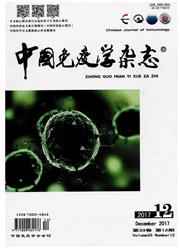

 中文摘要:
中文摘要:
目的:探讨与狼疮性肾炎相关的新西兰黑鼠(NZB)易感基因染色体位点。方法:通过建立(NZBXNZW)F1×NZW回交小鼠模型,以尿蛋白为狼疮性肾炎表现型,利用微卫星遗传标记进行基于数量性状位点(QTL)分析的全基因组扫描方法,寻找源于NZB的遗传易感基因位点并确定染色体位置。结果:根据QTL分析发现两个与狼疮鼠蛋白尿发生有关的易感基因位点,分别位于NZB小鼠第4号染色体的IMMit71区域及第17号染色体D17Mit22区域(LOD〉3.3)。同时携有两个NZB位点的小鼠尿蛋白阳性率最高,而只有一个位点的小鼠其尿蛋白阳性率较NZW纯合鼠也明显增高(P〈0.005)。结论:NZB第4号染色体的D4Mit71区域及第17号染色体的D17Mit22区域可能为(NZB×NZW)F1×NZW回交鼠狼疮性肾炎蛋白尿易感位点。两个位点之问具有协同增效作用。
 英文摘要:
英文摘要:
Objective: SLE is a complex autoimmune disease, which result in glomerulonephritis (Lupus nephritis, LN) due to immunecomplex-mediated inflammation. In this paper, the influence of correlated loci with susceptibility to LN was investigated in the NZB-derived on the development of mouse lupus nephritis and how the loci altered the penetrance of proteinuria in New Zealand mice. Methods: Female backcross mice were obtained by crossing female (NZB x NZW)F1 mice with male NZW mice. The onset of renal disease was monitored by biweekly testing for proteinuria. Linkages of particular microsatellite loci with development of proteinuria were estimated to identify chromosomal locations of QTL. The likelihood ratio statistic IDD of ≥3.3 was used as the threshold for statistically significant linkage. Results: Two relatively broad regions on chromosomes 4 and 17 with strong linkage were noted. One was located in the vicinity of NZB-type D4Mit71 on chromosome 4, and the other was in the vicinity of on chromosome 17 (LOD 〉 3.3). The onset and cumulative incidence of proteinuria were compared among these mice, in which two proteinuria-linked loci were showed of a gene-dosage effect. Thus, mice homozygous for NZB alleles at both chromosome 4 and 17 loci were showed as the highest cumulative incidence, respectively. Mice with one NZB alleles had higher proteinuria incidence compared with the mice homozygous for NZW alleles at these loci, P 〈 0. 005. Thus, it was conceivable that the suseeptihility to lupus nephritis in this baekemss mice was mainly determined by additive effeets contributed from each locus. Conclusion: Two novel susceptibility loci of lupus nephritis are located in the vicinity of NZB-type D4Mit71 on ehromosome 4 and of D17Mit22 on chromosome 17. Each locus eontributs to the manifestation of renal disease, which has additive effects in this backcross mice.
 同期刊论文项目
同期刊论文项目
 同项目期刊论文
同项目期刊论文
 期刊信息
期刊信息
